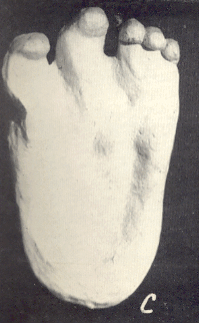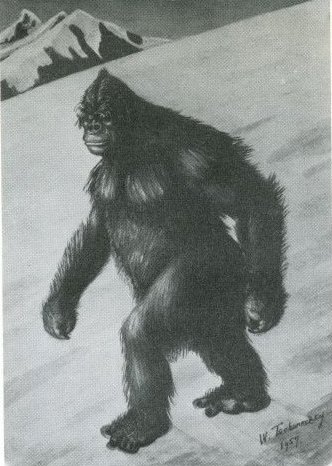That SITU Snowman Shipton Cast, Again
Posted by: Loren Coleman on June 7th, 2012

As I mentioned earlier, the Society for the Investigation of the Unexplained (SITU) archives are being organized by Michael Swords. During his sorting, he came across the Shipton artifacts in the collection. He shared the photograph above, and had this to say in one paragraph about SITU’s Shipton items:
This picture shows a cast of the famous Shipton Yeti print — which some argue cannot be true, as they believe that Shipton never made such a casting, as well as a “negative” [i.e. what the print would have actually looked like impressed into the snow], which, I would guess is the mold which Ivan used to pour his metal cast of the “bronze” showpiece Yeti print that he used to hang on his wall. I believe that I saw that showpiece briefly during the great initial box shuffling heroics, but at my age I might just simply be out of my mind. I’ll tell you later if I come across it as we head down the final laps of getting this beast organized. As to whether Ivan knew that the casting originally came from Shipton, or whether the cast used to make the print you see and the negative for the showpiece was just an artistic carving using good copies of the photography, I have no documentation seen in the collection yet anyway, and will also tell you if such surfaces. It IS odd that PURSUIT says rather flatly that the reproductions were from a “cast” if that wasn’t true, but what do I know?
Swords fairly says what is known. Sanderson/SITU had a cast. The cast went with a (negative) imprint model. A metal Yeti cast was made and has disappeared.
Let me restate, in bullet points, what history will not allow us to escape from, regarding the Shipton-Ward Yeti footprint imprints:
(1) The so-called “Shipton Yeti” foot imprints were discovered in Nepal in 1951 by Eric Shipton and Dr. Michael Ward.
(2) The “Shipton Yeti” foot tracks were only photographed. The record is absolutely clear about this. Those who have written about the photographs-only situation include Eric Shipton, Shipton friend Tom Bourdillon, Shipton biographer Peter Steele, anthropologist John Napier, Yeti expedition leader Edward Cronin, Snowman book author Odette Tchernine, unknown hominoid track historian Gian J. Quasar, and, especially significant regarding the SITU collection, Ivan T. Sanderson. Others have written of this track being photographed, but this sample should be enough. There is not one historical account of a cast or casts being taken because none were in the snow of Nepal. Casting of unknown hominoid prints developed later in the early days of more formalized cryptozoology studies in 1957-9 (in mud, dirt, soil, clay, and dust, but not snow until much later).
(3) Ivan T. Sanderson includes a drawing of the Shipton print in his 1961 book Abominable Snowmen: Legend Come to Life, and Sanderson is very specific about its origins. The drawing of the Shipton track in Sanderson’s 1961 appendix is captioned: “(9) ABSM (Meh-Teh). From photo of cast made from photo of print in snow, by Eric Shipton.”
(4) The infrequently-quoted mistaken caption in SITU’s non-peer-reviewed Pursuit of July 1971, shares incorrect information: “Imprint of right foot of ‘Yeti’, taken from a plaster cast made by Eric Shipton in snow on the Melung Glacier in 1951, on his reconnaissance of the route to conquer Mount Everest.” This photo caption is from a book review by Marion L. Fawcett, not by Ivan T. Sanderson. The caption is also incorrect about it being a “right foot,” for the Shipton track was of a left foot. The other caption used along with the noted review has other mistakes, such as identifying a cast of a California Bigfoot print as a cast of a “‘Suskwatch’ taken from mud on the banks of the Fraser River in British Columbia in 1959.” This was correctly identified as an Oh-Mah (Bigfoot) track from California in Ivan T. Sanderson’s Abominable Snowmen: Legend Come to Life. Marion L. Fawcett’s caption errors were multiple in her Pursuit review.
(5) The metal copy of the Shipton print that does appear to have been made from the “negative” shown by Michael Swords was the source of other SITU misques. SITU personnel incorrectly identified it, as I mentioned in an earlier posting, when in 1980 John A. Keel showed a mirror copy of this on the David Letterman show and said it was from a “Bigfoot in New Jersey.” Of course, it was not from a Bigfoot, and not a Bigfoot in New Jersey. It is an alleged Nepalese Yeti print replica.


On November 8, 1951, at 4:00 pm, British mountain climber Eric Shipton, while on one of the glaciers of the Menlung basin, Nepal, came across alleged Yeti tracks and photographed one print with an axe and separately the same track with a boot. A partial footprint is visible at the bottom of the axe photograph. No casts were taken of the Yeti foot tracks. Reconstructions of the photographed track were made afterward.

One of the earliest replicas of the print was Wladimir Tschernezky’s reconstruction. In Tschernezky’s own words: “Moulded on Shipton’s photograph of the footprint enlarged to its nature size, I modelled a plaster cast of the foot (Figure C in my new photographs).” Tschernezky’s replica appears to have been widely copied and shared among Tom Slick’s consultants, including with anthropologist Carleton Coon. There is reason to consider that Slick consultant, Ivan T. Sanderson, would also have received a copy.

Reconstruction of Meh-Teh by W. Tschernezky, 1957
For more complete sourcing, see “A Short History of the Shipton Snowman Track Photographs and the Tchernezky Cast,” and “Shipton Yeti Created Cast: Keel’s Misstatement.
About Loren Coleman
Loren Coleman is one of the world’s leading cryptozoologists, some say “the” leading living cryptozoologist. Certainly, he is acknowledged as the current living American researcher and writer who has most popularized cryptozoology in the late 20th and early 21st centuries.
Starting his fieldwork and investigations in 1960, after traveling and trekking extensively in pursuit of cryptozoological mysteries, Coleman began writing to share his experiences in 1969. An honorary member of Ivan T. Sanderson’s Society for the Investigation of the Unexplained in the 1970s, Coleman has been bestowed with similar honorary memberships of the North Idaho College Cryptozoology Club in 1983, and in subsequent years, that of the British Columbia Scientific Cryptozoology Club, CryptoSafari International, and other international organizations. He was also a Life Member and Benefactor of the International Society of Cryptozoology (now-defunct).
Loren Coleman’s daily blog, as a member of the Cryptomundo Team, served as an ongoing avenue of communication for the ever-growing body of cryptozoo news from 2005 through 2013. He returned as an infrequent contributor beginning Halloween week of 2015.
Coleman is the founder in 2003, and current director of the International Cryptozoology Museum in Portland, Maine.









